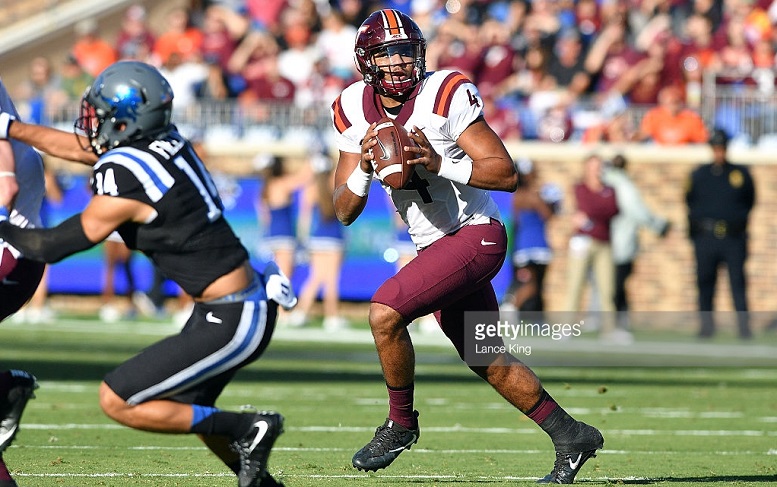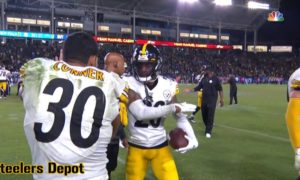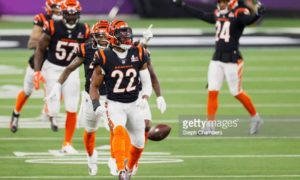From now until the 2017 NFL Draft takes place, we hope to showcase as many prospects as possible and examine both their strengths and weaknesses. Most of these profiles will feature individuals that the Pittsburgh Steelers are likely to have an interest in, while a few others will be top-ranked players. If there is a player you would like us to analyze, let us know in the comments below.
#4 Jerod Evans / QB / Virginia Tech: 6’3”, 230lbs
The Good:
– Extremely athletic and possesses big-play running ability
– Good Deep Accuracy
– Prototypical Physical Size
– Stands tall against pressure if necessary
– Great swagger/confidence and chemistry with teammates
The Bad:
– Limited Experience: Only played 14 games in his collegiate career
– Minimal exposure to pro-style passing schemes
– Was quick to leave the pocket at times, (not always a bad thing, since he regularly picked up positive yards; however, he could have let plays develop a little longer sometimes. This is a slightly nit-picky criticism.)
– Limited downfield passing opportunities at Virginia Tech (ran lots of RPOs, quick slants, etc. Deep passes generally came off of play action.)
– Ran a fairly slow 40-yard dash (4.80s); however, he played at a much faster speed in-game
– Inconsistent accuracy on shorter throws. However, this problem was seemly caused (at least in part) by hurrying his passes. This is a flaw that can be corrected naturally as he gains more experience, (experience will allow him to relax and slow down a little bit).
Bio:
– Career Passing: 14 Starts (10 wins, 4 losses), 63.5% completion rate, 3,552 yards (253.7 avg.), 29 TD 8 INT, 153.1 passer rating
– Career Rushing: 204 carries, 846 yards (4.1 avg.), 12 TD
– Trinity Valley Community College Stats: 8 games, 3,164 yards (395.5 avg.) 38 TD 3 INT
Film Breakdown:
It’s difficult to watch Jerod Evans’ film without being reminded of Cam Newton. Like Newton, Evans is a confident, dual threat quarterback with a strong arm and tremendous athleticism (especially for his size), who also excelled at a junior college before transferring up to the FBS. Although Cam was both bigger and faster coming out of college (Cam: 6’5” 245lbs w/4.59 40-yard dash; Evans: 6’3” 230lbs w/4.80 40-yard), both players have very similar styles, skillsets, throwing motions, and demonstrated comparable toughness within the pocket.
Additionally, also reminiscent of when Newton was going through the Draft process, there are legitimate questions about whether Evans can adapt and succeed within a professional offensive system. He has only appeared in 14 career games and played within a very limited spread-option offense at Virginia Tech, so his NFL future will undoubtedly be determined by whether he can continue to learn and grow once he is in the league.
This first clip is just one example of the resemblance between Newton and Evans. Notice the similar throwing motions, rhythm within the pocket and how both players tend to generate power by putting their entire bodies behind their throws:
In this next play against Eastern Carolina, Evans showcases his dynamic running ability, as well as his potential to score from anywhere on the field. It should also be noted that this was not a designed run, but instead was a product of Evans’ instinctual feel for the game and knack for escaping pressure in the pocket. No further explanation is need on this spectacular 55-yard touchdown run:
A subtle aspect of Evans’ game was his unflinching demeanor in the pocket and his willingness to take a hit if necessary. Although he possesses the ability to run and pick up yardage with his feet, he was never afraid to stand tall against a heavy incoming rush and beat a defense through the air. For example, in this play against Syracuse, despite getting drilled as he releases the ball, he shows great toughness by stepping into his throw and makes an accurate pass to get a first down. Evans’ courage in the face of pressure will surely benefit him at the next level:
One of the biggest questions about Evans’ ability to succeed in the NFL relate to his limited experience. While he was generally a very good decision-maker and took care of the football, he occasionally had negative plays that can be attributed to his on-field immaturity. For example, in this clip against Syracuse, rather than throwing the ball away or attempting to salvage the play with his feet, Evans forces a throw (off his back foot), into double-coverage in the red zone, resulting in a costly interception. It is likely that he will encounter some growing pains in the NFL while he gradually accumulates more playing time:
In this final clip against Clemson, Evans again throws an interception that I think can also be largely attributed to inexperience. It’s difficult to tell whether he is trying to throw the ball away or if he is tossing a jump-ball to his receiver, but either way it’s a bad decision. If he intended to throw it away, the ball has to be launched far out of bounds. Alternatively, if he intended to simply throw a jump-ball, this was a poor decision and a bad risk, given that it was only 2nd down and Virginia Tech was still in a competitive game. Although I don’t think plays like this are overly concerning when projecting his long-term future, they nevertheless indicate that there are some uncertainties regarding how his style will translate to the NFL:
Overall, Jerod Evans is an intriguing prospect who I think would be a quality selection if the Steelers feel compelled to take a quarterback in the later rounds of the Draft. To be clear, he obviously is not the same caliber player (and had nowhere near the same amount of production) as Cam Newton coming out of college; however, he did show flashes of a comparable skillset that could hint at a very high NFL-ceiling. As a result, although Evans has a lot of room to improve and will require time to learn the professional game from the sidelines, his combination physical tools and high upside could make him a great Day 3 sleeper.
Projection: Day 3
Games Watched: vs Boston College, at Notre Dame, vs Clemson, vs Tennessee, vs Eastern Carolina, at Syracuse













